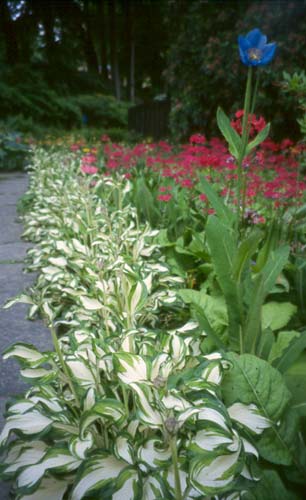
garden path at Sofiero, 5 km north of Helsingborg
A SWING THROUGH SOUTHERN SWEDEN
| Sweden has much in common with Denmark, and there’s a healthy dose of sibling rivalry between them. The Danes ruled southern Sweden for hundreds of years, and many of the towns here exhibit Danish architecture. Only in the 17th century did the Danes relinquish their last holdings in present-day Sweden. Language is nearly the same but with some different pronunciations and spellings. A look at a map shows the biggest difference between the two countries—Sweden covers a far greater portion of the earth’s surface! A crow flying from end to end would cover 1574 kilometers (978 miles) and go well above the Arctic Circle. I stayed in the southern third, which offers the most cultural interest. Compared to Denmark, the pace of life seems a bit quicker in Sweden, and the percentage of people who get around on bicycles a bit less. |
| A national bicycle trail follows the coast and makes navigation easy—one hardly needs a map. I enjoyed a pleasant mix of historic towns, rolling farmland, and vistas of the blue Baltic Sea. The Swedes are easy going about camping on public lands, and I was able to find a spot in the woods most nights. Hostels were another good option, and I stayed in several. Cost of travel seemed about the same as in Denmark. |
I sailed past "Hamlet's Castle," Elsinore, on a 20-minute ferry hop from Helsingør in Denmark to Helsingborg in Sweden. In Helsingborg, I made a short detour north to see the Sofiero gardens, famed for thousands of rhododendrons; most blooms had faded, but there were many other plants flowering their hearts out. That afternoon I turned south for the long ride around the coast.
The old town of Lund dated back to around A.D. 1000 and was one of my favorites in Sweden. Construction of the magnificent Romanesque cathedral had begun only one hundred years later. I gazed up inside to the lofty ceiling and the finely carved wooden furnishings all around, then gathered with other visitors in front of the astronomical clock. This is not the sort of clock that you’d put in your home unless you had a 10-meter (33-foot) ceiling—it was huge. At noon, the clock’s organ struck up In Dulci Jubilo, wooden soldiers on top clashed swords, little doors opened, and a succession of wise men and other figures paraded in front of Mary and Jesus. Giant dials displayed astronomical and astrological events. Outside, students thronged the streets; the university here has been going since 1666. In the afternoon I wandered through the open-air museum, Kulturen, a group of about 40 historic houses. Each one reflected town or rural life of past centuries; many also had historic or art collections. Swedish folk dances took place on one of the squares. Women worked on a giant floral cross, attaching bits of greenery and flowers for the upcoming midsummer festivities.
I rolled into eerily silent Malmö the next morning. The impressive Sankt Petri Kyrka (ca. 1346) was open, but most everything else was shut down for midsummer’s Eve. After a look at the fine old architecture around the large square, I headed on down the coast. Soon I passed under the enormous eight-kilometer-long Öresund Bridge, a massive project that gave Sweden a direct land link to Denmark and the rest of Europe beginning in the summer of 2000.
Winds kicked up and passing thunderstorms livened up the ride around the southwest corner of Sweden, then gave me a big push to Ystad, another picturesque old town. Hundreds of half-timbered houses lined the cobblestone streets—Ystad had been Sweden’s main port from about 1658 to 1850. I visited two of the historic churches, but the museums were closed for Midsummer Day. I continued to Ales Stenar, a prehistoric stone ship memorial set up on a windswept bluff overlooking the Baltic Sea. Large stones of the 1500-year-old site formed an oval 67 meters (220 feet) long oriented to the midsummer sunset and midwinter sunrise. Poppies and other flowers shone in the sun.
Back in 1680, the Swedish king decided to build a fortress in Karlskrona that would outdo any other navy or fortress of the time. Fortifications on the outer islands gave added protection. Today, Karlskrona is packed with fine examples of 17th and 18th century naval architecture. I took in the churches, art gallery, naval museum, and walks around the huge central square. The naval museum, built recently on its own pier, just happened to be located over an old shipwreck; an underwater tunnel gives a close-up look at the thick planks of the hull. One morning I took a ferry out to Apso Island to see the very solid old fort guarding the way to Karlskrona.
The weather has continued to be surprisingly cool, with brief showers on all but one day in southern Sweden. Powerful winds helped propel me across the south coast. Despite the March-like temperatures, the favorite summertime food in Scandinavia has to be the ice cream cone; people enjoying the outdoors rarely seem to be without one!
Heading up the east coast, I spent an enjoyable afternoon in the old port city of Kalmar. (You may have heard of the Kalmar Union that the rulers of Sweden, Denmark, and Norway forged here in 1397; this arrangement lasted a bit more than 100 years before squabbles split it up.) The magnificent Kalmar Castle still stands from those times. I strolled through some of the old royal chambers with their coffered ceilings, frescoes, and furnishings. An Easter banquet table replica had been laid out to show the types of foods eaten then; those royals were as decadent as the Romans when it came to nonstop eating. The castle prison offered sobering exhibits on how women were punished in the old days; none of the techniques were nice. Other halls held a big exhibition on the close ties between Sweden and Poland. The chapel seemed to be THE place to get married—three weddings took place there that Saturday afternoon. Also in Kalmar, I took in the local art museum, which had three floors of contemporary art—one floor dedicated to the latest Swedish art, one to Polish artists, and one to older Swedish paintings.
Then on to skinny, 137-km-long Öland Island, just 6 km offshore. I had heard that cyclists couldn't ride across the bridge (actually only between 7 a.m. and 7 p.m., I found out later), and at the bus station a driver lied to me that there was no free bus (there was). So it cost me $6, but I made it across ok. By the way, buses and trains are very expensive in Scandinavia. Because I’m cycling, I’ve probably saved the equivalent of the airfare from the USA—almost like a free trip! Anyway, cycling is a lot more fun.
Öland—one long history book—contains hundreds of prehistoric sites. Burial grounds, marked by stones in oval and other patterns date from Roman Iron Age to Viking times. I saw Viking rune stones with dragon and other drawings along with the old script. Several stone ring forts also go back to the Viking era. The ring fort at Eskatorp had been partially reconstructed, but I especially liked the undisturbed Ismantorp fortress with its 88 houses and nine gates in a remote forested section of the island’s interior. At the south tip of the island I climbed the Långe Jan lighthouse (1785), said to be Scandinavia’s highest at 42 meters. A flock of swans nibbled at the seabed just offshore. Öland boosters claim that the island has 400 windmills, more than Holland. Locals once built them as status symbols—no farm would be without one.
The heavens poured rain on my last day in Öland. Previously showers had lasted no more than a few hours during the day, but now the rain seemed determined to stay. A woman in a tourist office told me with a straight face (Swedes always say things with a straight face) that the rain would last four days. I splashed back to the bridge, stopping to see the Vida Museum to see beautiful works, most in glass; I liked the glass “boats” and faces; a video showed how the artists created the pieces.
The rain wouldn’t quit that day and persisted into the following morning when I rolled into Oskarshamn. I dried out in the library and walked upstairs to a pair of museums, one on maritime history and the other of humorous woodcarvings. That night I rolled onto my ship for Gotland—the largest of the Baltic Islands, and like Öland, a treasure trove of historic sites.
The large ferry docked under glorious sunshine early the next morning in the medieval town of Visby. Old stone walls and 40 towers still enclosed the heart of this former trade center, which reached the height of its glory during the 12th and 13th centuries. I wandered the quiet cobblestone streets and admired the towers and old churches, some in ruins. Later, after drying out my gear, I headed north into rural Gotland, famous for its 92 village churches, many of which have medieval frescoes. I took in some of the churches along with the excellent Bunge open-air museum collection of windmills, watermills, schoolhouse, farms, and fishing huts. A short ferry ride off the northeast coast took me across to Fåro Island, noted for its strange sea stacks or “raukar” formations; they made a memorable sight as the sun sank low in the sky and a fog bank slowly rolled in.
From Gotland, instead of going back to Oskarshamn, I took a ferry north to Nynäshamn, within striking distance that day of Sweden’s famed capital. Centered on islands where Lake Mälaren meets the Baltic Sea, Stockholm’s setting makes it one of the world’s most beautiful cities. Ships and boats of all sizes cruise the central waterways and out to the Baltic Sea.
I parked Bessie Too for five nights inside the Backpackers Inn, a basic summer hostel in a school, while I took off seeing the sights. First on the list was the huge royal palace, Kungliga Slott, an 18th century abode with 608 rooms of chandeliers, imposing portraits, glittering jewels, elaborate coaches, and a grand Hall of State. One sort of room was not in evidence, however. A guide, with a straight face, told me that there were no bathrooms when I asked where I could get a drink of water! I guess the king only comes over to this palace for short visits!
That evening I ventured into the Vasa Museum, one of the world's most famous, for a look at the extravagant 17th-century flagship Vasa. The great ship had one too many gun decks, as it turned out, and rolled over and sank in the harbor on its maiden voyage in 1628. Divers raised it in 1961, and archaeologists painstakingly reassembled the ship. Hundreds of wooden statues and royal symbols cover the vessel, which is amazingly well preserved.
Skansen, nearby on a hill, turned out to be another great place to visit with hundreds of historic village and town buildings in a giant park. Other Skansen attractions included a walk-thru lemur colony, an aquarium, and a collection of Swedish wildlife (the animals—not the parties). Folk music and folk dancing ended a glorious day.
I had three more wonderful days of sights and walks in Stockholm. A big crowd gathered at the Kungliga Slott at mid-day for the changing of the guard, a spectacular performance of precision marching and music. The royal chapel also had some fine music, too—a Bach recital on the organ. The nearby Storkyrkan (Gamla Stan, the old town, is packed with churches.) had a huge and terrifying painting of The Last Judgment, while a life-size statue of St. George on horseback put an end to a fierce two-headed dragon. A climb up the Storkyrkan's tower led to a great panorama of central Stockholm. In the afternoon I hopped on boats for cruises of the canals and a look at city life and parks; many Swedes lay on the shore baking in the warm sun.
The skies poured rain early the next morning, but stopped as I trekked around to a bunch of museums—the maritime museum had superb ship models as well as exhibits on life at sea. The Tekniska museum displayed a collection of bicycles and other machinery in a great hall; I visited with radio hams in their well-equipped station in the Telemuseum next door. I dropped in to the Ethnografiska Museet for a look at how Swedes viewed "exotic" cultures. The Historika Museet offered large and excellent displays on Viking life and medieval church art. Finally, the Nationalmuseum displayed fine paintings by European greats and Swedish artists in an impressive 19th century building.
On Sunday, I returned to Gamla Stan and the royal chapel for Sunday service and a spirited talk by the pastor, though in Swedish. Then—you guessed it—more churches. The Riddarholmskyrkan hosted a wonderful concert by a brass ensemble of military cadets; later I wandered around the church and its many royal caskets (and ghosts?). Over at the German church, I admired the 19th-century stained glass. The day ended with a three-hour cruise amidst the Stockhom Archipelago and a flaming sunset. I was on my way across the Baltic Sea to Estonia.

garden
path at Sofiero, 5 km north of Helsingborg
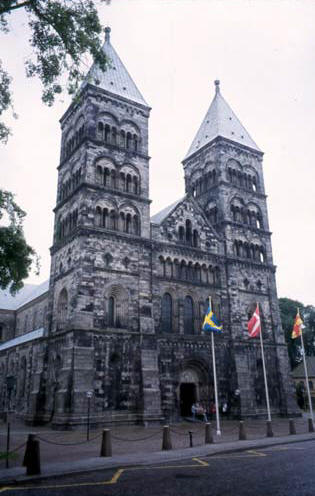 |
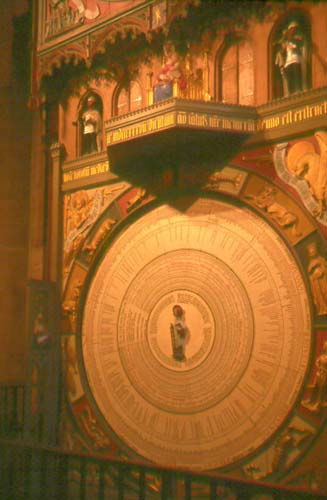 |
|
Lund Cathedral |
Astronomical clock inside Lund Cathedral |
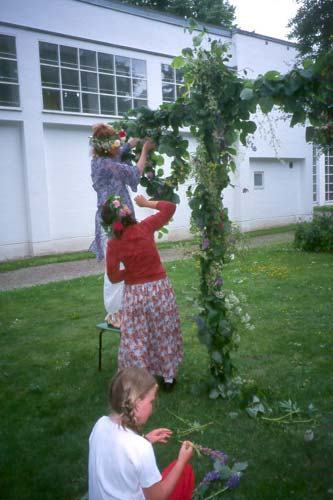
Decorating
the Midsummer Cross at Kulturen in Lund
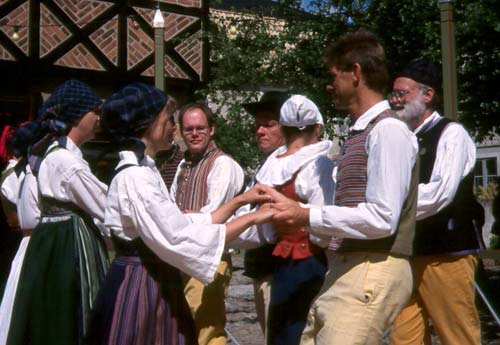
A Swedish folk dance
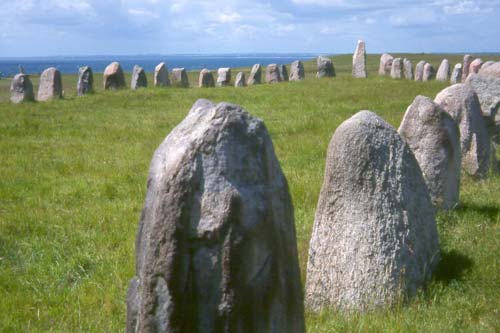
Ales Stenar

Karlskrona's Marinmuseum tells the story of the Swedish navy.
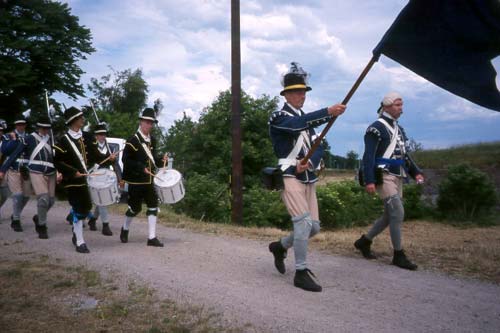
A reenactment outside Drottningskärs kastel
on the island of Aspö, outside Karlskrona
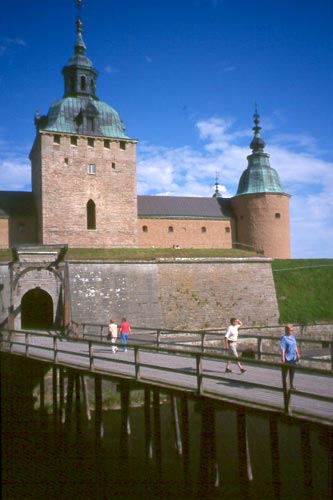
Kalmar
Slott
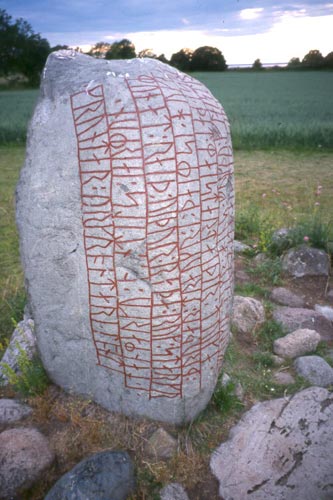
Karlevistenen, a rune stone near Karlevi on
Öland Island, eulogizes a 10th-century Viking
chieftain.

Öland Island road hazard
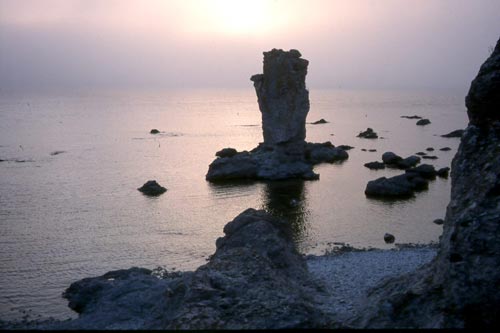
Raukar formations (seastacks) punctuate some of Fårö
Island's coastline.

Gaia
by sculptor Pye Engström
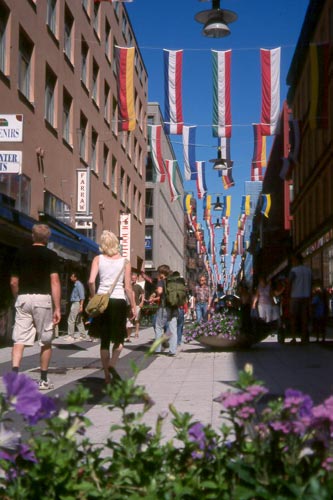
Drottninggatan
in central Stockholm
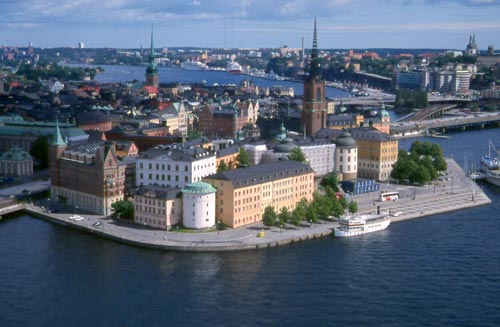
Gamla Stan—the oldest part of Stockholm—lies on several islands in the
middle of the city.
Riddarholmskyrkan, the church tower on the right, dates from
the late 13th century
and is now a royal necropolis. I took this photo from
the Stadshuset (Town Hall) tower.
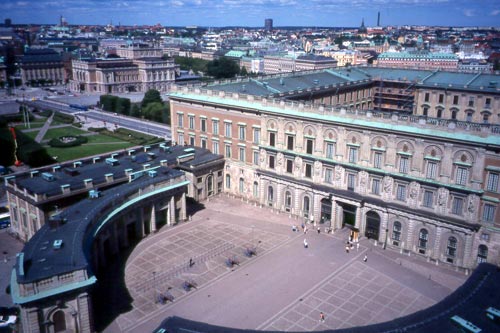
The main entrance to Kungliga Slottet, the 'new' (18th century) Royal Palace
Changing of the Guard takes place in the courtyard.
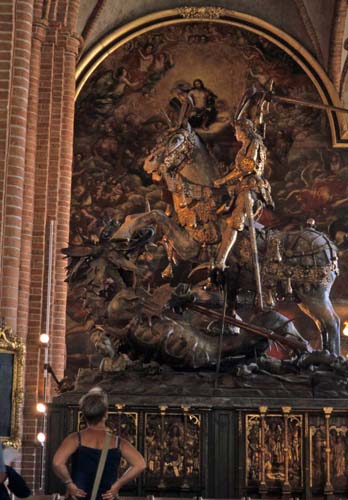
A
life-size St. George slays his dragon.
German sculptor Berndt Notke created this
work in 1489.
The massive Last Judgment painting from 1696 covers the far wall.
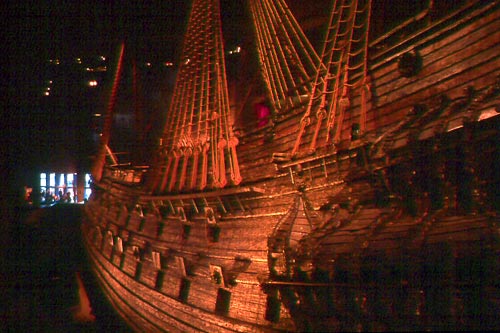
The top-heavy Vasa sank in full view of townspeople on 10 August 1628,
then
was raised from the seabed in 1961. Most of what you see is original material.
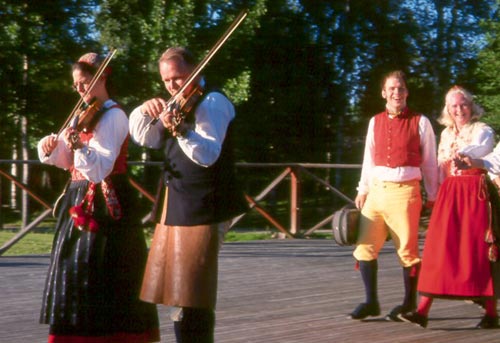
Artur Hazelius founded Skansen in 1891 to show how the Swedes lived in the old days.
The open-air museum now has about 150 houses and other buildings from farms and
towns all over the country.

A walk-through lemur habitat is another attraction at Skansen.
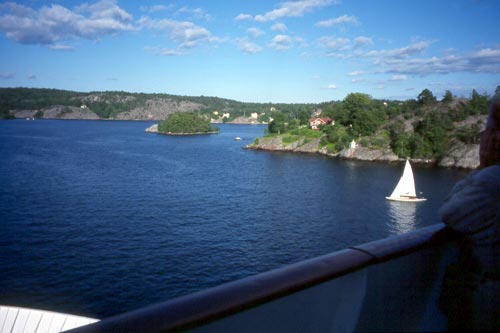
Saying
good by to Stockholm.
The ferry ride to Estonia began with a three-hour cruise
through
the Stockholm Archipelago before heading out into the Baltic.